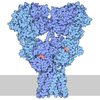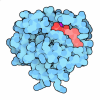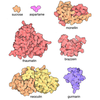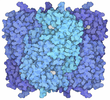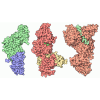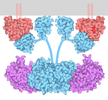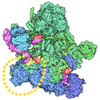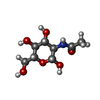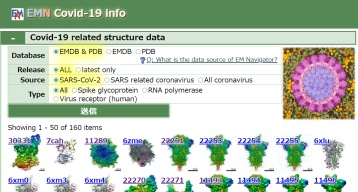[English] 日本語
 Yorodumi
Yorodumi- PDB-8y1v: Structure of GluN1b-GluN2D NMDA receptor in complex with competit... -
+ Open data
Open data
- Basic information
Basic information
| Entry | Database: PDB / ID: 8y1v | ||||||||||||||||||||||||||||||
|---|---|---|---|---|---|---|---|---|---|---|---|---|---|---|---|---|---|---|---|---|---|---|---|---|---|---|---|---|---|---|---|
| Title | Structure of GluN1b-GluN2D NMDA receptor in complex with competitive antagonist R-CPP and allosteric inhibitor YY-23 | ||||||||||||||||||||||||||||||
 Components Components |
| ||||||||||||||||||||||||||||||
 Keywords Keywords | MEMBRANE PROTEIN/INHIBITOR / ion channel / calcium permeable / glutamate receptor / neuronal expression / MEMBRANE PROTEIN / MEMBRANE PROTEIN-INHIBITOR complex | ||||||||||||||||||||||||||||||
| Function / homology |  Function and homology information Function and homology informationglycine-gated cation channel activity / regulation of sensory perception of pain / excitatory chemical synaptic transmission / Synaptic adhesion-like molecules / response to glycine / propylene metabolic process / cellular response to L-glutamate / Assembly and cell surface presentation of NMDA receptors / regulation of monoatomic cation transmembrane transport / NMDA glutamate receptor activity ...glycine-gated cation channel activity / regulation of sensory perception of pain / excitatory chemical synaptic transmission / Synaptic adhesion-like molecules / response to glycine / propylene metabolic process / cellular response to L-glutamate / Assembly and cell surface presentation of NMDA receptors / regulation of monoatomic cation transmembrane transport / NMDA glutamate receptor activity / voltage-gated monoatomic cation channel activity / NMDA selective glutamate receptor complex / Neurexins and neuroligins / glutamate binding / ligand-gated sodium channel activity / neurotransmitter receptor complex / calcium ion transmembrane import into cytosol / protein heterotetramerization / glycine binding / startle response / monoatomic cation transmembrane transport / positive regulation of reactive oxygen species biosynthetic process / Negative regulation of NMDA receptor-mediated neuronal transmission / Unblocking of NMDA receptors, glutamate binding and activation / positive regulation of calcium ion transport into cytosol / Long-term potentiation / excitatory synapse / monoatomic cation transport / monoatomic ion channel complex / regulation of neuronal synaptic plasticity / positive regulation of excitatory postsynaptic potential / synaptic cleft / positive regulation of synaptic transmission, glutamatergic / calcium ion homeostasis / glutamate-gated receptor activity / glutamate-gated calcium ion channel activity / presynaptic active zone membrane / EPHB-mediated forward signaling / ligand-gated monoatomic ion channel activity involved in regulation of presynaptic membrane potential / ionotropic glutamate receptor signaling pathway / sodium ion transmembrane transport / Ras activation upon Ca2+ influx through NMDA receptor / synaptic membrane / hippocampal mossy fiber to CA3 synapse / adult locomotory behavior / regulation of membrane potential / excitatory postsynaptic potential / transmitter-gated monoatomic ion channel activity involved in regulation of postsynaptic membrane potential / synaptic transmission, glutamatergic / postsynaptic density membrane / brain development / visual learning / regulation of synaptic plasticity / calcium ion transmembrane transport / long-term synaptic potentiation / terminal bouton / synaptic vesicle / signaling receptor activity / amyloid-beta binding / RAF/MAP kinase cascade / response to ethanol / dendritic spine / chemical synaptic transmission / postsynaptic membrane / calmodulin binding / neuron projection / postsynaptic density / calcium ion binding / synapse / dendrite / endoplasmic reticulum membrane / protein-containing complex binding / glutamatergic synapse / cell surface / positive regulation of transcription by RNA polymerase II / plasma membrane / cytoplasm Similarity search - Function | ||||||||||||||||||||||||||||||
| Biological species |  Homo sapiens (human) Homo sapiens (human) | ||||||||||||||||||||||||||||||
| Method | ELECTRON MICROSCOPY / single particle reconstruction / cryo EM / Resolution: 4.2 Å | ||||||||||||||||||||||||||||||
 Authors Authors | Zhang, J.L. / Zhu, S.J. / Guo, F. | ||||||||||||||||||||||||||||||
| Funding support |  China, 9items China, 9items
| ||||||||||||||||||||||||||||||
 Citation Citation |  Journal: To Be Published Journal: To Be PublishedTitle: A novel antidepressant acting via allosteric inhibition of GluN2D-incorporated NMDA receptors at GABAergic interneurons Authors: Zhang, J.L. / Zhu, S.J. / Fei, G. | ||||||||||||||||||||||||||||||
| History |
|
- Structure visualization
Structure visualization
| Structure viewer | Molecule:  Molmil Molmil Jmol/JSmol Jmol/JSmol |
|---|
- Downloads & links
Downloads & links
- Download
Download
| PDBx/mmCIF format |  8y1v.cif.gz 8y1v.cif.gz | 726.4 KB | Display |  PDBx/mmCIF format PDBx/mmCIF format |
|---|---|---|---|---|
| PDB format |  pdb8y1v.ent.gz pdb8y1v.ent.gz | Display |  PDB format PDB format | |
| PDBx/mmJSON format |  8y1v.json.gz 8y1v.json.gz | Tree view |  PDBx/mmJSON format PDBx/mmJSON format | |
| Others |  Other downloads Other downloads |
-Validation report
| Summary document |  8y1v_validation.pdf.gz 8y1v_validation.pdf.gz | 1.4 MB | Display |  wwPDB validaton report wwPDB validaton report |
|---|---|---|---|---|
| Full document |  8y1v_full_validation.pdf.gz 8y1v_full_validation.pdf.gz | 1.4 MB | Display | |
| Data in XML |  8y1v_validation.xml.gz 8y1v_validation.xml.gz | 79.1 KB | Display | |
| Data in CIF |  8y1v_validation.cif.gz 8y1v_validation.cif.gz | 121.1 KB | Display | |
| Arichive directory |  https://data.pdbj.org/pub/pdb/validation_reports/y1/8y1v https://data.pdbj.org/pub/pdb/validation_reports/y1/8y1v ftp://data.pdbj.org/pub/pdb/validation_reports/y1/8y1v ftp://data.pdbj.org/pub/pdb/validation_reports/y1/8y1v | HTTPS FTP |
-Related structure data
| Related structure data |  38847MC M: map data used to model this data C: citing same article ( |
|---|---|
| Similar structure data | Similarity search - Function & homology  F&H Search F&H Search |
- Links
Links
- Assembly
Assembly
| Deposited unit | 
|
|---|---|
| 1 |
|
- Components
Components
| #1: Protein | Mass: 97777.914 Da / Num. of mol.: 2 Source method: isolated from a genetically manipulated source Source: (gene. exp.)  Homo sapiens (human) / Gene: GRIN1, NMDAR1 / Plasmid: pEG-BacMam / Cell line (production host): HEK293S GnTI- cells / Organ (production host): KIDNEY / Production host: Homo sapiens (human) / Gene: GRIN1, NMDAR1 / Plasmid: pEG-BacMam / Cell line (production host): HEK293S GnTI- cells / Organ (production host): KIDNEY / Production host:  Homo sapiens (human) / References: UniProt: Q05586 Homo sapiens (human) / References: UniProt: Q05586#2: Protein | Mass: 99057.328 Da / Num. of mol.: 2 Source method: isolated from a genetically manipulated source Source: (gene. exp.)  Homo sapiens (human) / Gene: GRIN2D, GluN2D, NMDAR2D / Cell line (production host): HEK293S GnTl- cells / Organ (production host): KIDNEY / Production host: Homo sapiens (human) / Gene: GRIN2D, GluN2D, NMDAR2D / Cell line (production host): HEK293S GnTl- cells / Organ (production host): KIDNEY / Production host:  Homo sapiens (human) / References: UniProt: O15399 Homo sapiens (human) / References: UniProt: O15399#3: Sugar | ChemComp-NAG / #4: Chemical | Mass: 592.804 Da / Num. of mol.: 2 / Source method: obtained synthetically / Formula: C34H56O8 / Feature type: SUBJECT OF INVESTIGATION Has ligand of interest | Y | Has protein modification | Y | |
|---|
-Experimental details
-Experiment
| Experiment | Method: ELECTRON MICROSCOPY |
|---|---|
| EM experiment | Aggregation state: PARTICLE / 3D reconstruction method: single particle reconstruction |
- Sample preparation
Sample preparation
| Component | Name: N-methyl-D-aspartate receptors / Type: COMPLEX / Entity ID: #1-#2 / Source: RECOMBINANT |
|---|---|
| Molecular weight | Value: 400 kDa/nm / Experimental value: NO |
| Source (natural) | Organism:  Homo sapiens (human) Homo sapiens (human) |
| Source (recombinant) | Organism:  Homo sapiens (human) / Cell: HEK293S GnTl- cells / Plasmid: pEG-BacMam Homo sapiens (human) / Cell: HEK293S GnTl- cells / Plasmid: pEG-BacMam |
| Buffer solution | pH: 8 |
| Specimen | Conc.: 2 mg/ml / Embedding applied: YES / Shadowing applied: NO / Staining applied: NO / Vitrification applied: YES |
| Specimen support | Grid material: GOLD / Grid mesh size: 300 divisions/in. / Grid type: Quantifoil R1.2/1.3 |
| EM embedding | Details: The protein sample of N-methyl-D-aspartate receptors was reconstructed into artificial nanodiscs composed by soya bean lecithin and MSP1E3D1 protein. Material: nanodisc |
| Vitrification | Instrument: FEI VITROBOT MARK IV / Cryogen name: ETHANE / Humidity: 100 % / Chamber temperature: 46.4 K |
- Electron microscopy imaging
Electron microscopy imaging
| Experimental equipment | 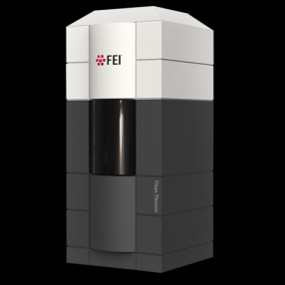 Model: Titan Krios / Image courtesy: FEI Company |
|---|---|
| Microscopy | Model: FEI TITAN KRIOS |
| Electron gun | Electron source:  FIELD EMISSION GUN / Accelerating voltage: 300 kV / Illumination mode: FLOOD BEAM FIELD EMISSION GUN / Accelerating voltage: 300 kV / Illumination mode: FLOOD BEAM |
| Electron lens | Mode: BRIGHT FIELD / Nominal defocus max: 2500 nm / Nominal defocus min: 1500 nm |
| Specimen holder | Cryogen: NITROGEN / Specimen holder model: FEI TITAN KRIOS AUTOGRID HOLDER |
| Image recording | Electron dose: 60 e/Å2 / Detector mode: SUPER-RESOLUTION / Film or detector model: DIRECT ELECTRON DE-10 (5k x 4k) / Num. of grids imaged: 1 / Num. of real images: 6016 |
| Image scans | Movie frames/image: 40 / Used frames/image: 1-40 |
- Processing
Processing
| EM software |
| ||||||||||||||||||||||||||||||||||||
|---|---|---|---|---|---|---|---|---|---|---|---|---|---|---|---|---|---|---|---|---|---|---|---|---|---|---|---|---|---|---|---|---|---|---|---|---|---|
| CTF correction | Type: PHASE FLIPPING AND AMPLITUDE CORRECTION | ||||||||||||||||||||||||||||||||||||
| Particle selection | Num. of particles selected: 605501 | ||||||||||||||||||||||||||||||||||||
| 3D reconstruction | Resolution: 4.2 Å / Resolution method: FSC 0.143 CUT-OFF / Num. of particles: 82019 / Num. of class averages: 3 / Symmetry type: POINT | ||||||||||||||||||||||||||||||||||||
| Atomic model building | Protocol: RIGID BODY FIT | ||||||||||||||||||||||||||||||||||||
| Atomic model building | PDB-ID: 7YFF Accession code: 7YFF / Source name: PDB / Type: experimental model |
 Movie
Movie Controller
Controller


 PDBj
PDBj